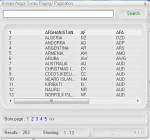SQL IN Operator
The SQL IN operator is used with the WHERE clause in the SELECT statement, this can be used to look to the dataset matching the condition and looking in the supplied data, in easier words, the IN operator can make further selections in the selected data.
The SQL IN operator can also be used to write nested SQL queries, the nested query first fetches some data and then the wrapper query select or simply filters more from the selected data.
Now let's see the IN operator in Action.
SQL IN Syntax



